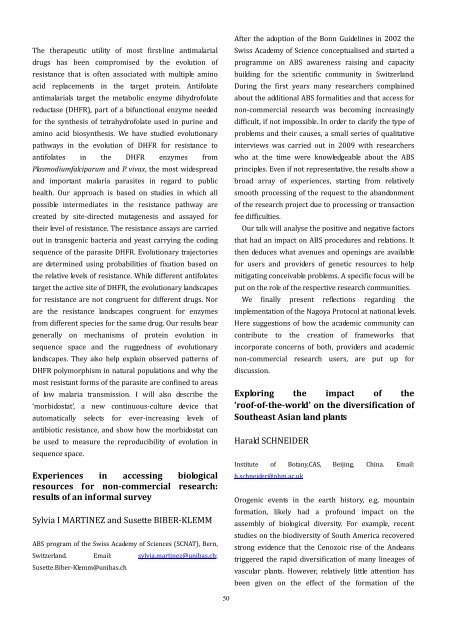Welcome to the 31st IUBS General Assembly and Conference on ...
Welcome to the 31st IUBS General Assembly and Conference on ...
Welcome to the 31st IUBS General Assembly and Conference on ...
Create successful ePaper yourself
Turn your PDF publications into a flip-book with our unique Google optimized e-Paper software.
The <str<strong>on</strong>g>the</str<strong>on</strong>g>rapeutic utility of most first‐line antimalarial<br />
drugs has been compromised by <str<strong>on</strong>g>the</str<strong>on</strong>g> evoluti<strong>on</strong> of<br />
resistance that is often associated with multiple amino<br />
acid replacements in <str<strong>on</strong>g>the</str<strong>on</strong>g> target protein. Antifolate<br />
antimalarials target <str<strong>on</strong>g>the</str<strong>on</strong>g> metabolic enzyme dihydrofolate<br />
reductase (DHFR), part of a bifuncti<strong>on</strong>al enzyme needed<br />
for <str<strong>on</strong>g>the</str<strong>on</strong>g> syn<str<strong>on</strong>g>the</str<strong>on</strong>g>sis of tetrahydrofolate used in purine <str<strong>on</strong>g>and</str<strong>on</strong>g><br />
amino acid biosyn<str<strong>on</strong>g>the</str<strong>on</strong>g>sis. We have studied evoluti<strong>on</strong>ary<br />
pathways in <str<strong>on</strong>g>the</str<strong>on</strong>g> evoluti<strong>on</strong> of DHFR for resistance <str<strong>on</strong>g>to</str<strong>on</strong>g><br />
antifolates in <str<strong>on</strong>g>the</str<strong>on</strong>g> DHFR enzymes from<br />
Plasmodiumfalciparum <str<strong>on</strong>g>and</str<strong>on</strong>g> P. vivax, <str<strong>on</strong>g>the</str<strong>on</strong>g> most widespread<br />
<str<strong>on</strong>g>and</str<strong>on</strong>g> important malaria parasites in regard <str<strong>on</strong>g>to</str<strong>on</strong>g> public<br />
health. Our approach is based <strong>on</strong> studies in which all<br />
possible intermediates in <str<strong>on</strong>g>the</str<strong>on</strong>g> resistance pathway are<br />
created by site‐directed mutagenesis <str<strong>on</strong>g>and</str<strong>on</strong>g> assayed for<br />
<str<strong>on</strong>g>the</str<strong>on</strong>g>ir level of resistance. The resistance assays are carried<br />
out in transgenic bacteria <str<strong>on</strong>g>and</str<strong>on</strong>g> yeast carrying <str<strong>on</strong>g>the</str<strong>on</strong>g> coding<br />
sequence of <str<strong>on</strong>g>the</str<strong>on</strong>g> parasite DHFR. Evoluti<strong>on</strong>ary trajec<str<strong>on</strong>g>to</str<strong>on</strong>g>ries<br />
are determined using probabilities of fixati<strong>on</strong> based <strong>on</strong><br />
<str<strong>on</strong>g>the</str<strong>on</strong>g> relative levels of resistance. While different antifolates<br />
target <str<strong>on</strong>g>the</str<strong>on</strong>g> active site of DHFR, <str<strong>on</strong>g>the</str<strong>on</strong>g> evoluti<strong>on</strong>ary l<str<strong>on</strong>g>and</str<strong>on</strong>g>scapes<br />
for resistance are not c<strong>on</strong>gruent for different drugs. Nor<br />
are <str<strong>on</strong>g>the</str<strong>on</strong>g> resistance l<str<strong>on</strong>g>and</str<strong>on</strong>g>scapes c<strong>on</strong>gruent for enzymes<br />
from different species for <str<strong>on</strong>g>the</str<strong>on</strong>g> same drug. Our results bear<br />
generally <strong>on</strong> mechanisms of protein evoluti<strong>on</strong> in<br />
sequence space <str<strong>on</strong>g>and</str<strong>on</strong>g> <str<strong>on</strong>g>the</str<strong>on</strong>g> ruggedness of evoluti<strong>on</strong>ary<br />
l<str<strong>on</strong>g>and</str<strong>on</strong>g>scapes. They also help explain observed patterns of<br />
DHFR polymorphism in natural populati<strong>on</strong>s <str<strong>on</strong>g>and</str<strong>on</strong>g> why <str<strong>on</strong>g>the</str<strong>on</strong>g><br />
most resistant forms of <str<strong>on</strong>g>the</str<strong>on</strong>g> parasite are c<strong>on</strong>fined <str<strong>on</strong>g>to</str<strong>on</strong>g> areas<br />
of low malaria transmissi<strong>on</strong>. I will also describe <str<strong>on</strong>g>the</str<strong>on</strong>g><br />
‘morbidostat’, a new c<strong>on</strong>tinuous‐culture device that<br />
au<str<strong>on</strong>g>to</str<strong>on</strong>g>matically selects for ever‐increasing levels of<br />
antibiotic resistance, <str<strong>on</strong>g>and</str<strong>on</strong>g> show how <str<strong>on</strong>g>the</str<strong>on</strong>g> morbidostat can<br />
be used <str<strong>on</strong>g>to</str<strong>on</strong>g> measure <str<strong>on</strong>g>the</str<strong>on</strong>g> reproducibility of evoluti<strong>on</strong> in<br />
sequence space.<br />
Experiences in accessing biological<br />
resources for n<strong>on</strong>commercial research:<br />
results of an informal survey<br />
Sylvia I MARTINEZ <str<strong>on</strong>g>and</str<strong>on</strong>g> Susette BIBER‐KLEMM<br />
ABS program of <str<strong>on</strong>g>the</str<strong>on</strong>g> Swiss Academy of Sciences (SCNAT), Bern,<br />
Switzerl<str<strong>on</strong>g>and</str<strong>on</strong>g>. Email: sylvia.martinez@unibas.ch;<br />
Susette.Biber‐Klemm@unibas.ch<br />
After <str<strong>on</strong>g>the</str<strong>on</strong>g> adopti<strong>on</strong> of <str<strong>on</strong>g>the</str<strong>on</strong>g> B<strong>on</strong>n Guidelines in 2002 <str<strong>on</strong>g>the</str<strong>on</strong>g><br />
Swiss Academy of Science c<strong>on</strong>ceptualised <str<strong>on</strong>g>and</str<strong>on</strong>g> started a<br />
programme <strong>on</strong> ABS awareness raising <str<strong>on</strong>g>and</str<strong>on</strong>g> capacity<br />
building for <str<strong>on</strong>g>the</str<strong>on</strong>g> scientific community in Switzerl<str<strong>on</strong>g>and</str<strong>on</strong>g>.<br />
During <str<strong>on</strong>g>the</str<strong>on</strong>g> first years many researchers complained<br />
about <str<strong>on</strong>g>the</str<strong>on</strong>g> additi<strong>on</strong>al ABS formalities <str<strong>on</strong>g>and</str<strong>on</strong>g> that access for<br />
n<strong>on</strong>‐commercial research was becoming increasingly<br />
difficult, if not impossible. In order <str<strong>on</strong>g>to</str<strong>on</strong>g> clarify <str<strong>on</strong>g>the</str<strong>on</strong>g> type of<br />
problems <str<strong>on</strong>g>and</str<strong>on</strong>g> <str<strong>on</strong>g>the</str<strong>on</strong>g>ir causes, a small series of qualitative<br />
interviews was carried out in 2009 with researchers<br />
who at <str<strong>on</strong>g>the</str<strong>on</strong>g> time were knowledgeable about <str<strong>on</strong>g>the</str<strong>on</strong>g> ABS<br />
principles. Even if not representative, <str<strong>on</strong>g>the</str<strong>on</strong>g> results show a<br />
broad array of experiences, starting from relatively<br />
smooth processing of <str<strong>on</strong>g>the</str<strong>on</strong>g> request <str<strong>on</strong>g>to</str<strong>on</strong>g> <str<strong>on</strong>g>the</str<strong>on</strong>g> ab<str<strong>on</strong>g>and</str<strong>on</strong>g><strong>on</strong>ment<br />
of <str<strong>on</strong>g>the</str<strong>on</strong>g> research project due <str<strong>on</strong>g>to</str<strong>on</strong>g> processing or transacti<strong>on</strong><br />
fee difficulties.<br />
Our talk will analyse <str<strong>on</strong>g>the</str<strong>on</strong>g> positive <str<strong>on</strong>g>and</str<strong>on</strong>g> negative fac<str<strong>on</strong>g>to</str<strong>on</strong>g>rs<br />
that had an impact <strong>on</strong> ABS procedures <str<strong>on</strong>g>and</str<strong>on</strong>g> relati<strong>on</strong>s. It<br />
<str<strong>on</strong>g>the</str<strong>on</strong>g>n deduces what avenues <str<strong>on</strong>g>and</str<strong>on</strong>g> openings are available<br />
for users <str<strong>on</strong>g>and</str<strong>on</strong>g> providers of genetic resources <str<strong>on</strong>g>to</str<strong>on</strong>g> help<br />
mitigating c<strong>on</strong>ceivable problems. A specific focus will be<br />
put <strong>on</strong> <str<strong>on</strong>g>the</str<strong>on</strong>g> role of <str<strong>on</strong>g>the</str<strong>on</strong>g> respective research communities.<br />
We finally present reflecti<strong>on</strong>s regarding <str<strong>on</strong>g>the</str<strong>on</strong>g><br />
implementati<strong>on</strong> of <str<strong>on</strong>g>the</str<strong>on</strong>g> Nagoya Pro<str<strong>on</strong>g>to</str<strong>on</strong>g>col at nati<strong>on</strong>al levels.<br />
Here suggesti<strong>on</strong>s of how <str<strong>on</strong>g>the</str<strong>on</strong>g> academic community can<br />
c<strong>on</strong>tribute <str<strong>on</strong>g>to</str<strong>on</strong>g> <str<strong>on</strong>g>the</str<strong>on</strong>g> creati<strong>on</strong> of frameworks that<br />
incorporate c<strong>on</strong>cerns of both, providers <str<strong>on</strong>g>and</str<strong>on</strong>g> academic<br />
n<strong>on</strong>‐commercial research users, are put up for<br />
discussi<strong>on</strong>.<br />
Exploring <str<strong>on</strong>g>the</str<strong>on</strong>g> impact of <str<strong>on</strong>g>the</str<strong>on</strong>g><br />
‘roofof<str<strong>on</strong>g>the</str<strong>on</strong>g>world’ <strong>on</strong> <str<strong>on</strong>g>the</str<strong>on</strong>g> diversificati<strong>on</strong> of<br />
Sou<str<strong>on</strong>g>the</str<strong>on</strong>g>ast Asian l<str<strong>on</strong>g>and</str<strong>on</strong>g> plants<br />
Harald SCHNEIDER<br />
Institute of Botany,CAS, Beijing, China. Email:<br />
h.schneider@nhm.ac.uk<br />
Orogenic events in <str<strong>on</strong>g>the</str<strong>on</strong>g> earth his<str<strong>on</strong>g>to</str<strong>on</strong>g>ry, e.g. mountain<br />
formati<strong>on</strong>, likely had a profound impact <strong>on</strong> <str<strong>on</strong>g>the</str<strong>on</strong>g><br />
assembly of biological diversity. For example, recent<br />
studies <strong>on</strong> <str<strong>on</strong>g>the</str<strong>on</strong>g> biodiversity of South America recovered<br />
str<strong>on</strong>g evidence that <str<strong>on</strong>g>the</str<strong>on</strong>g> Cenozoic rise of <str<strong>on</strong>g>the</str<strong>on</strong>g> Andeans<br />
triggered <str<strong>on</strong>g>the</str<strong>on</strong>g> rapid diversificati<strong>on</strong> of many lineages of<br />
vascular plants. However, relatively little attenti<strong>on</strong> has<br />
been given <strong>on</strong> <str<strong>on</strong>g>the</str<strong>on</strong>g> effect of <str<strong>on</strong>g>the</str<strong>on</strong>g> formati<strong>on</strong> of <str<strong>on</strong>g>the</str<strong>on</strong>g><br />
50
















